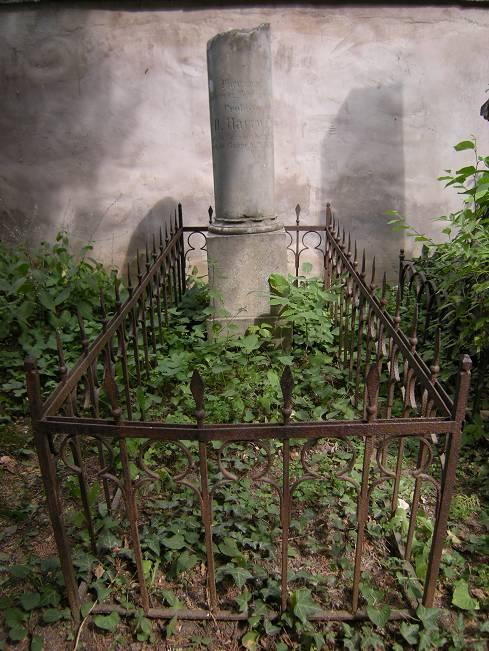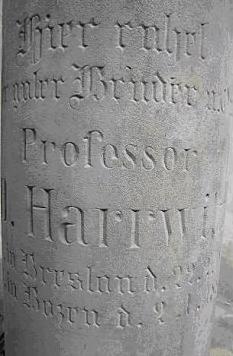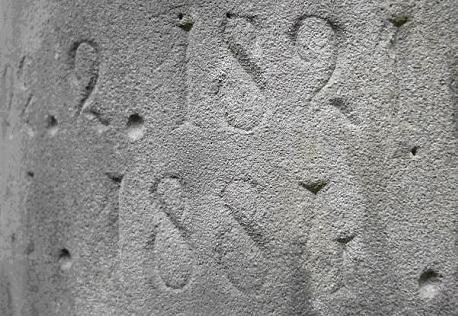Chess
Notes
|
| First column | << previous | Archives [61] | next >> | Current column |
6243. Postage stamps (C.N. 2366)
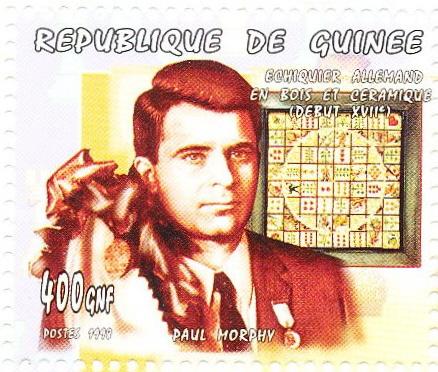
In C.N. 2366 (see page 311 of A Chess Omnibus)
Daniël De Mol (Wetteren, Belgium) reported that in 1998
Guinea issued a postage stamp which misidentified
Spassky as Morphy. We are grateful to our correspondent
for enabling us to reproduce the faulty stamp here,
together with the rest of the set.
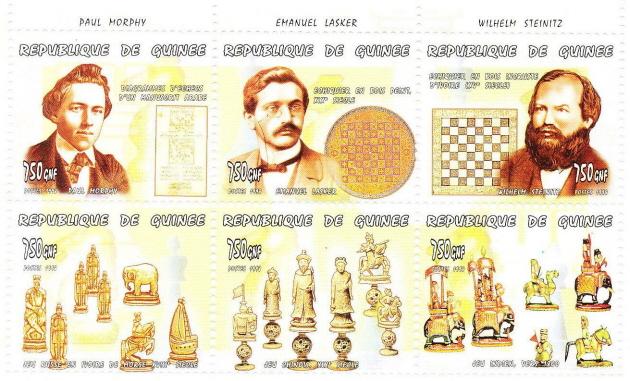
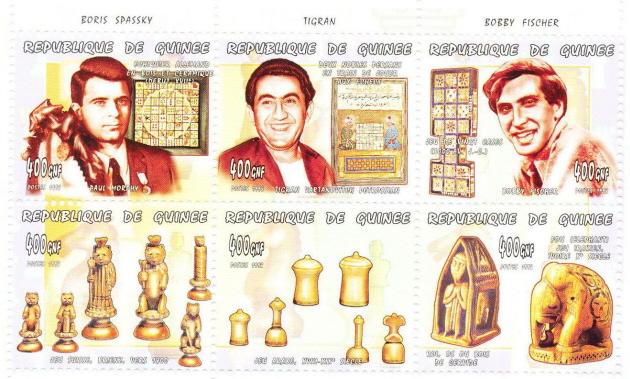
6244. Mr and Mrs Piatigorsky (C.N.s 6200 & 6224)
Nikolai Brunni (Honolulu, HI, USA) has found several of Jacqueline Piatigorsky’s games in Chess Life, 1955. The most interesting is this loss:
Irene Vines – Jacqueline PiatigorskyUS Women’s Championship, New York, 1955
Stonewall Defence
1 d4 d5 2 Nf3 c6 3 e3 e6 4 Bd3 f5 5 c4 Bd6 6 Nc3 Nh6 7 O-O Nd7 8 b3 O-O 9 Bb2 Nf6 10 Ne5 Bd7 11 Qc2 Nfg4 12 Nd1 Bxe5 13 dxe5 Nxh2 14 Kxh2 Qh4+ 15 Kg1 Ng4 16 Re1 Be8 17 Kf1 Bh5
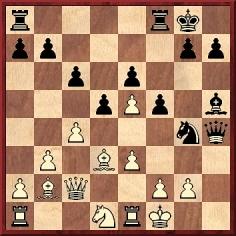
18 Ke2 Nxf2+ 19 Kd2 Nxd1 20 Raxd1 Bxd1 21 Kxd1 Rfd8 22 Ke2 Rd7 23 Ba3 Qg4+ 24 Kf1 h5 25 Bd6 h4 26 Kg1 g5 27 Qf2 Qh5 28 cxd5 cxd5
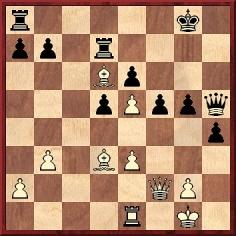
29 Bxf5 exf5 30 Qxf5 Rf7 31 Qe6 Kg7 32 Qxd5 g4 33 Qd4 Kh6 34 e6 Rf5 35 Bf4+ Kg6 36 Qd7 Qh7 37 e7 Qf7 38 Qd8 Qe8 39 Rd1 Rc5 40 Qd6+ Kf7 41 Qxc5 Rc8 42 Qf5+ Kg8 43 Qe6+ Kh7 44 Qh6+ Kg8 45 Be5 Resigns.
Source: Chess Life, 20 October 1955, pages 5 and 7.
6245. My System (C.N. 6237)
Below is the errata list for the 1929 edition of
Nimzowitsch’s My System:
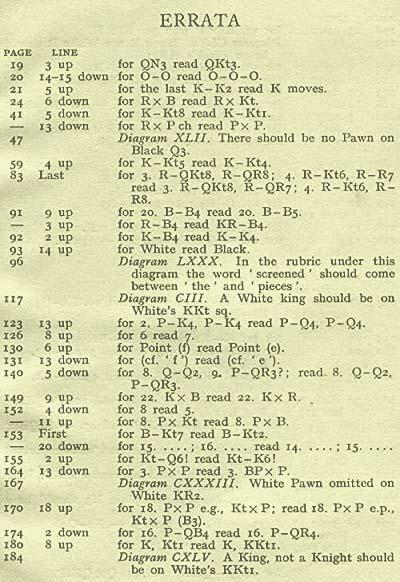
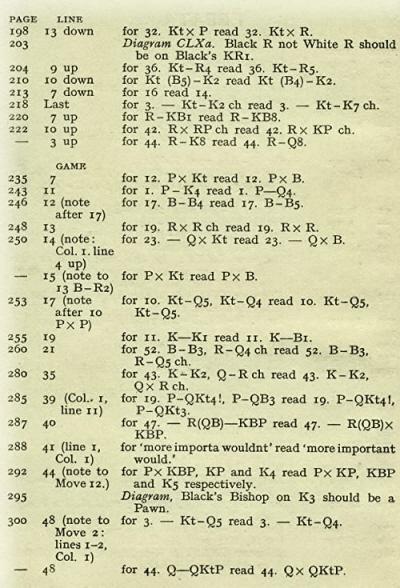
The 302-page edition brought out by Bell in 1929 was
published the following year by Harcourt, Brace and
Company, New York. One of our copies was inscribed by
a world champion on whom Nimzowitsch had considerable
influence:
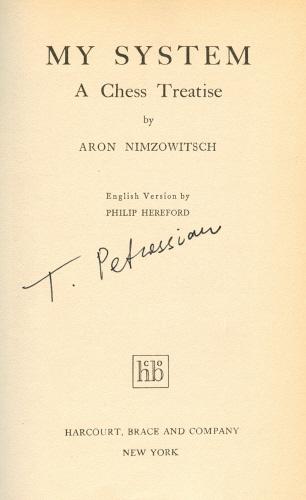
6246. Autobiographies
James Macdonald (Hackenack, NJ, USA) seeks recommendations for high-quality chess autobiographies by lesser-known players, such as Chess Memoirs by Joseph Platz (Coraopolis, 1979) and A Chess Explorer by Hugh Myers (Davenport, 2002).
Readers’ suggestions are invited.
6247. Geography
C.N. 1202 (see page 159 of Chess Explorations) referred to a Capablanca book whose author stated that the 1933 Folkestone Olympiad was held in the United States. Here, we add that on page 136 of the March 1978 BCM D.J. Morgan mentioned two US books which located the 1904 Cambridge Springs tournament in England.
See page 25 of Dictionary of Modern Chess by Byrne J. Horton (New York, 1959) and page 144 of The World of Chess by A. Saidy and N. Lessing (New York, 1974).
6248. Canal’s date and place of birth (C.N. 5831)
The photograph of Esteban Canal’s grave in C.N. 5831
showed 1893 as his year of birth, whereas reference
books say that he was born on 19 April 1896, in
Chiclayo, Peru.
Luca D’Ambrosio (Bolzano, Italy) now provides Canal’s death certificate, which creates further confusion by stating that the master was born on 19 April 1897, in Chielago (sic), Peru:
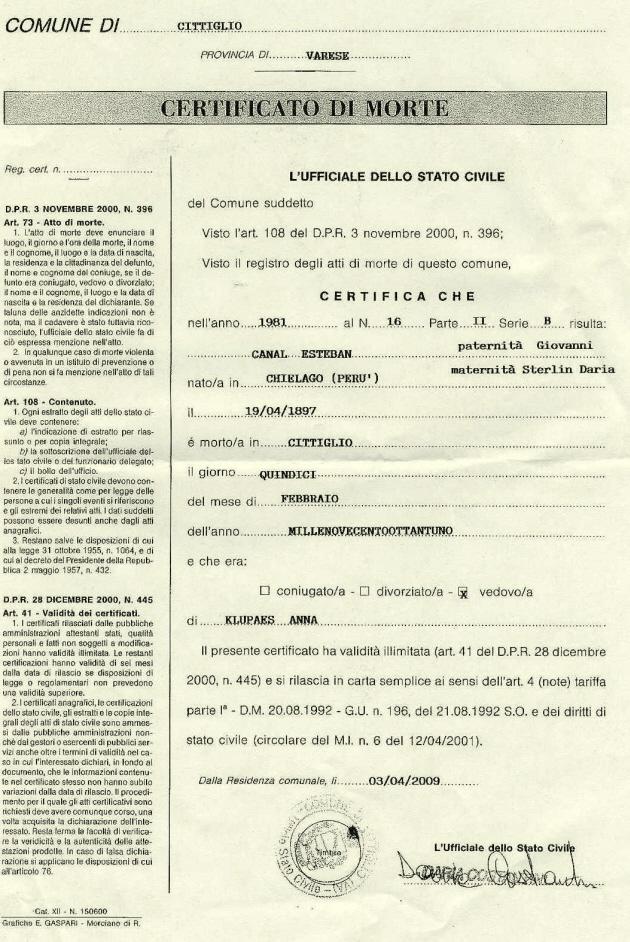
Our correspondent also notes that whereas it is usually reported that Canal died on 14 February 1981 in Cocquio-Trevisago, the death certificate has 15 February 1981 and Cittiglio.
6249. An uneventful game?
1 d4 d5 2 e3 Nf6 3 Bd3 c5 4 c3 Nc6 5 f4 e6 6 Nf3 Ne4 7 O-O f5 8 Ne5 Nxe5 9 fxe5 Bd7 10 Nd2 Be7 11 Nxe4 dxe4 12 Bc4 b5 13 Bb3 c4 14 Bc2 O-O 15 Bd2 Bc6 16 Qh5 Qe8 17 Qxe8 Rfxe8 18 a4 a6 19 b4 Reb8 20 Ra2 g5 21 Rfa1 Kf7 22 axb5 axb5 23 Rxa8 Bxa8 24 Ra7 Bb7 25 Bd1 Kg6 26 g3 Bd8 27 Be2 Bb6 28 Ra1 h5 29 h4 Ra8 30 Rxa8 Bxa8 31 Kf2 Bd8 32 hxg5 Bxg5
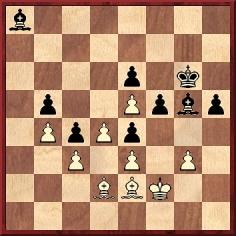
33 Bf1 h4 34 Bc1 Bc6 35 Kg2 Be8 36 Kh3 hxg3 37 Kxg3 Kh5 38 Be2+ Kh6 Drawn.
Such a quiet game seemingly deserves scant attention, but that may not be so. It was played by Marshall and Capablanca in the fifth round of the New York tournament on 26 January 1911 (the day after the Capablanca v Black game discussed in C.N. 6239). Page 9 of the New York Times, 27 January 1911 reported:
‘The game did not produce the exciting play hoped for, as both players were ultra-conservative, taking no chances whatever, the game finally being recorded as a draw after 38 moves.’
Page 49 of the March 1911 American Chess Bulletin made the general remark on the tournament that ‘not a hitch occurred to mar the smoothness of the proceedings’, and the game-score was given on page 58 of the same issue:
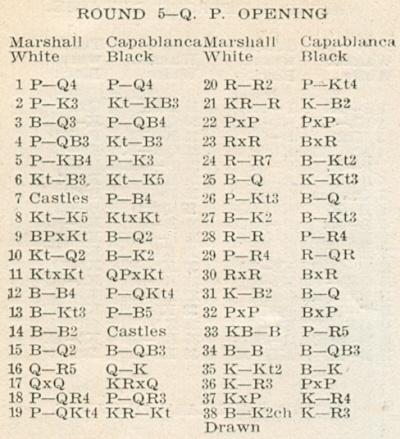
However, a report on page 71 of Deutsches Wochenschach, 19 February 1911 (based on an account in the New Yorker Staats-Zeitung) suggested a less pleasant story:
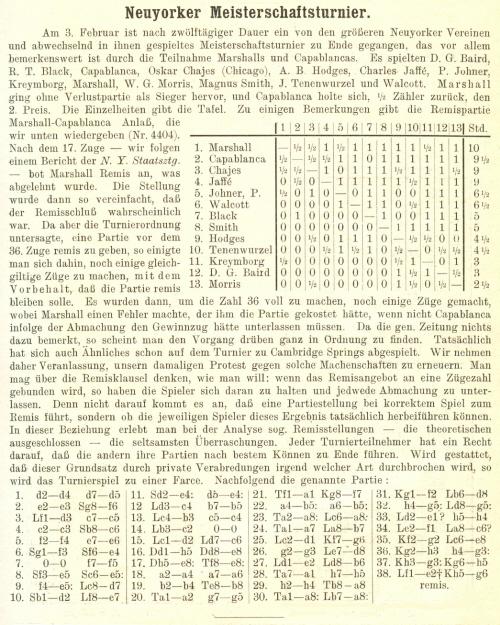
The report was picked up on page 100 of the March 1911 BCM:
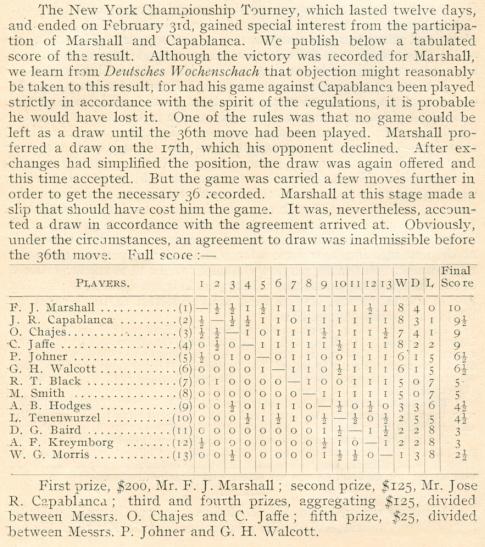
What is to be made of all this? We note that the game-scores in the American Chess Bulletin and Deutsches Wochenschach are slightly different (leaving aside the discrepancy over 38...Kh6/Kg6). According to the Bulletin, play from our diagram above continued 33 Bf1 h4 34 Bc1 Bc6, whereas the German magazine gave 33 Be1 h4 34 Bf1 Bc6. In the latter version, 34...Bc6 would indeed deserve a question mark, since Black can play 34...hxg3+. If, though, the game-score in the Bulletin is accurate, the story of a missed win collapses.
6250. More from Cardoza
Tarrasch was Russian; Steinitz was German; Francois Philodor wrote Analyse des Eschecs; Lasker published little; Capablanca lost to Lasker in the last round of St Petersburg, 1914; there were 13 draws in the 1921 world championship match; after 1948 Michael Botvinnik held the world title ‘for a short while’ until he lost it to Smyslov.
This, and much else similarly awry, is in the brief chess section of Silberstang’s Encyclopedia of Games & Gambling by Edwin Silberstang (New York, 1996).
6251. Halpern’s Chess Symposium (C.N. 6209)
A small addition from page 65 of the March 1911 American Chess Bulletin:

6252. Sir John Simon in India
Tony Gillam (Nottingham, England) sends this cutting from page 11 of the Times of India, 13 February 1928:
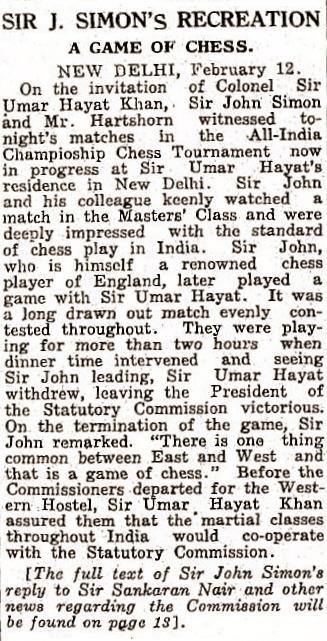
For Sir John Simon’s comments on chess in India and on Sultan Khan, see our feature article A Chessplaying Statesman. Two games won by Sultan Khan in the All-India Championship (Delhi, 1928) were given in R.N. Coles’ monograph on him (St Leonards-on-Sea, 1965 and 1977).
Sir John Simon discussed his work as Chairman of the Indian Commission on pages 144-156 of his memoirs Retrospect (London, 1952).
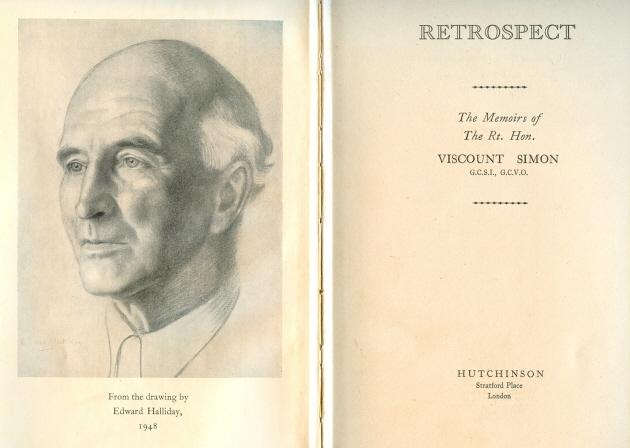
6253. Autobiographies (C.N. 6246)
Timothy J. Bogan (Chicago, IL, USA) recommends Lacking the Master Touch by Wolfgang Heidenfeld (Cape Town, 1970) and adds that ‘an anthology of his contributions to various chess magazines would be very welcome’.
Three books have been recommended by Hassan Roger Sadeghi (Lausanne, Switzerland): Le maître de l’attaque by Victor Soultanbéieff (Paris, 1974), Predicament in 2-Dimensions by Ariel Mengarini (Davenport, 1979) and Chess Gladiator by Asa Hoffmann (Seattle, 1996).
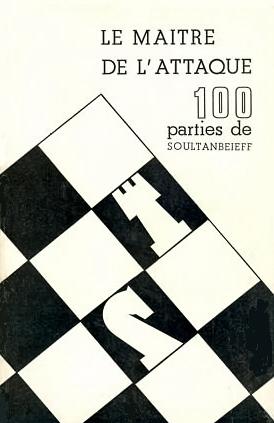
6254. A familiar miniature
Is it possible to find further details (including, in particular, the exact occasion) of the familiar Raphael v Montgomery miniature? The score: 1 e4 c5 2 f4 e5 3 Nf3 Nc6 4 Bc4 d6 5 d3 Bg4 6 O-O Nd4 7 Bxf7+ Ke7 8 fxe5 Bxf3 9 Bg5+ Kd7 10 e6+ Kc6 11 Bxd8 Bxd1 12 Be8 mate.
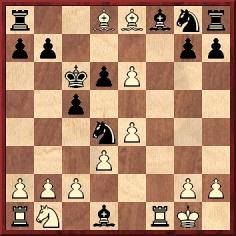
The game was given on page 204 of the June 1856 Deutsche Schachzeitung:
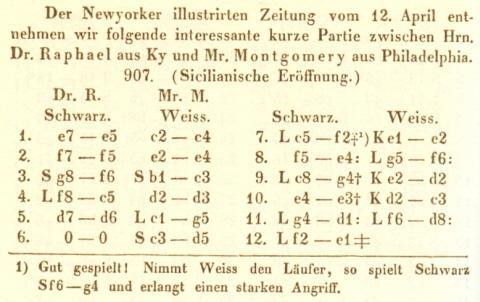
6255. The things they write
From the (unnumbered) page regarding a Steinitz v Chigorin game in Solitaire Chess by I.A. Horowitz (New York, 1962):

6256. Thierry Le Luron
The greatest impressionist/imitator we have seen is Thierry Le Luron (1952-86). The photograph below, which comes from an unidentified French magazine, shows him playing chess against one of his innumerable impersonation ‘victims’, Alice Sapritch:
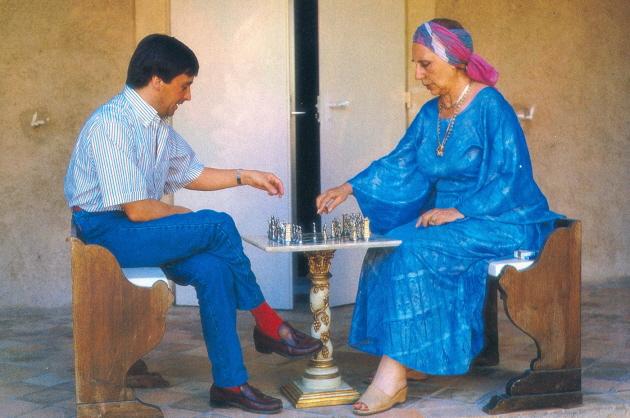
In books by and about Le Luron we recall no references to an interest in chess.
Our collection includes a copy, dedicated to Chantal Goya and Jean-Jacques Debout, of his book Comme trois pommes (Paris, 1978).
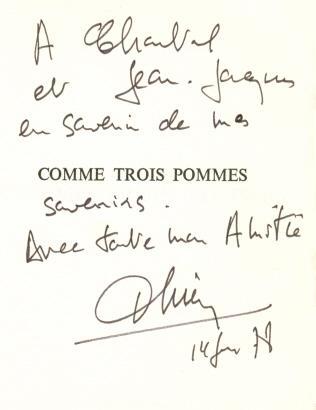
6257. Predictions on Fischer v Spassky (C.N.s 2737 & 5681)
In an article ‘Masters and Experts View the Match’ by Bill Goichberg on pages 409-410 of the July 1972 Chess Life & Review several respondents (Herbert Seidman, Harry Borochow, Joseph Platz and John N. Jacobs) predicted that Fischer would defeat Spassky 12½-8½.
Reuben Fine’s prediction, Fischer by 12½-7½, was accompanied by the comment:
‘The odds are now (March) 4 to 2 that the Russians will dodge the match, using it as a political football.’
On page 15 of Bobby Fischer’s Conquest of the World’s Chess Championship (New York, 1973) Fine wrote:
‘The road was now clear for the final match with Spassky. Bobby was the favorite. I predicted that he would win 12½ to 8½. Others came up with other figures.’
6258. Prins v Soultanbéieff
Tony Foley (Passage West, Ireland) asks whether the full score is available of the game between Lodewijk Prins and Victor Soultanbéieff at Hastings, 1949-50 (Premier Reserves).
Soultanbéieff gave only the conclusion on pages 169-170 of Le maître de l’attaque (Paris, 1974):
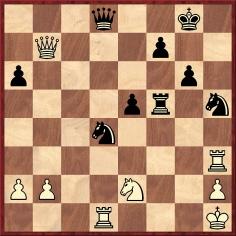
34...Qf6 35 Ng3 Nxg3+ 36 Rxg3 Ne2 37 Rdg1 Rf1 38 b4 Qf4 39 R3g2
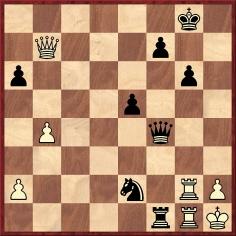
39...Qf2 40 Qc8+ Kg7 41 Qc5 Rxg1+ 42 Rxg1 Qf3+ 43 Rg2 Qf1+ 44 Rg1 Ng3+ 45 hxg3 Qh3 mate.
An illustration from page xviii of Internationaal Schaaktournooi Zaanstreek 1946 by W.A.T. Schelfhout and C. Kottnauer (Amsterdam, 1946):
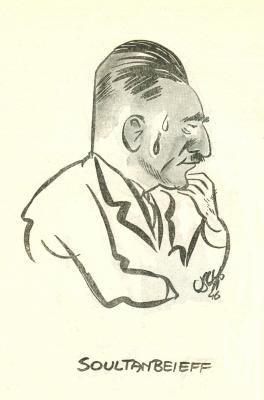
6259. Nabokov (C.N. 6202)
In C.N. 6202 John Roycroft asked whether any reader could shed light on the name Дюсер in a 1924 sonnet by Vladimir Nabokov, the line being ‘Там Филидор сражался и Дюсер’.
Dan Scoones (Port Coquitlam, BC, Canada) has drawn our attention to a Russian webpage where Gennady Nesis proposed two theories. Below is the relevant text, in a translation supplied by Mr Roycroft:
‘The coffee house frequented by Philidor can only be the Parisian Café de la Régence, first opened in 1718 and patronized by chessplayers for two centuries. They included many famous names, such as Voltaire, J.-J. Rousseau, D. Diderot and, later, B. Franklin, M. Robespierre and Napoleon Bonaparte. Among the Russians were I. Turgenev and M. Chigorin. So whom could Nabokov have had in mind?
The first candidate is Sire de Légall (1702-1792), tutor to Philidor, but I have an alternative to propose.
It is known that the future Emperor Paul of Russia and his spouse Maria Fyodorovna paid France an unofficial visit in 1782. To obviate the conventions of protocol, the son of the Empress Ekaterina [name corrected to ‘Ekaterina’, i.e. Catherine the Great, by Mr Roycroft, whose original translation had ‘Elizabeth’] travelled under the pseudonym of Count Severny. We now cite a “Bibliography” published in Paris in 1864: “In the summer of 1782 an unprepossessing gentleman of small stature dropped in to the Régence and stood watching one of the chess contestants. The unknown guest indicated a move he thought was the best and, encountering surprise, made a wager of one louis d’or that he was right. Winning his bet he handed the gold coin to a dumbstruck manservant and departed without a word. Only then did those present guess that the lavish guest was none other than Paul, heir to the Russian throne.”
So why Дюсер? Perhaps the common particle “de” or “du” preceding a name in France indicates a connection at the court, while сер is the initial syllable of “sérénissime” (most serene) or even “Sire” (sovereign).
Be that as it may, our readers may care to rack their brains on this riddle.’
6260. Who?
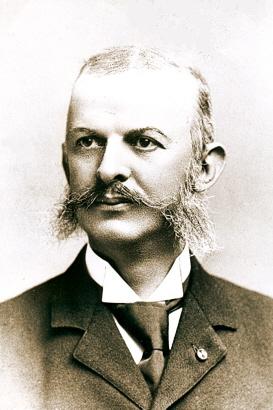
An article in Lasker’s Chess Magazine described him as the world’s best solver of chess problems.
6261. Mr and Mrs Piatigorsky (C.N.s 6200, 6224 & 6244)
We are grateful to Andy Ansel (Laurel Hollow, NY, USA), John Blackstone (Las Vegas, NV, USA) and Ian Matthew (Portsmouth, England) for further game-scores. All have been forwarded to Jules Welling, our correspondent who made the appeal.
6262. Predictions on Fischer v Spassky (C.N.s 2737, 5681 & 6257)
Jonathan Berry (Nanaimo, BC, Canada) quotes from page 21 of the September 1972 issue of Chess Canada:
‘Chess Canada’s Spassky-Fischer Contest Winners
Thirteen correct predictions were received by Chess Canada and each of these will receive a credit for $50 worth of books. The people correctly predicting a score of 12½-8½ were H. Winston, M. Mares, R. Eberlein, I. Zalys, C. Dwyer, P. Arens, R. Joho, J. Musumeci, J. Sember, H. Brodie, W. Browne, J. Burstow and the UBC Chess Club.
The final score of 12½-8½ was predicted 13 times, as was 12½-9½. The next most common prediction was 12½-10½ with 7. Fifty-seven entrants expected a Fischer win while ten predicted Spassky and only three expected a tie.’
We wonder in passing whether an authoritative tally has been established of books on the 1972 match. Below, taken at random, is one of the many:
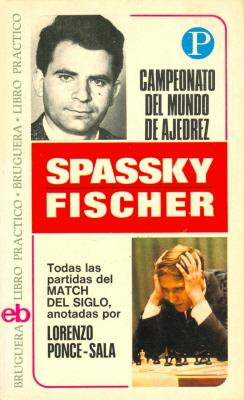
6263. Petroff Defence
So many openings books warn of the disadvantages for Black of the 3 Nxe5 Nxe4 line in the Petroff Defence that it is surprising to find a game in which Black gives mate at move 11. From page 76 of the May 1918 Schweizerische Schachzeitung:
K. Schirm – C. DresdnerWinter tournament, Berlin Chess Club, 1917-18
Petroff Defence
1 e4 e5 2 Nf3 Nf6 3 Nxe5 Nxe4 4 Qe2 d5 5 d3 Bd6 6 Nxf7 Kxf7 7 dxe4 Re8 8 Qh5+ Kf8 9 Qxd5 Bb4+ 10 Kd1 Qxd5+ 11 exd5 Re1 mate.
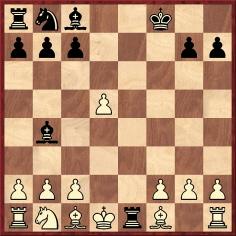
6264. Breyer and the last throes (C.N. 6223)
From page 26 of Evans on Chess by Larry Evans (New York, 1974):
‘... Richard Reti, who in 1919 startled the chessworld by announcing that “White’s game is in its last throes” after 1 P-K4.’
6265. W. Paulsen v J. Berger
Johan Van Aelst (Antwerp, Belgium) has a question about the game W. Paulsen v J. Berger, Berlin, 1881, which is in various databases as follows:
1 e4 e5 2 d4 exd4 3 Qxd4 Nc6 4 Qe3 d6 5 Bd2 Be7 6 Bc3 Bf6 7 f4 Qe7 8 Bb5 Bd7 9 Nf3 Nh6 10 Bxf6 Qxf6 11 Nc3 O-O 12 O-O-O Rfe8 13 h3 Qe7 14 g4 f5 15 Bc4+ Be6 16 Nd5 Bxd5 17 Bxd5+ Kh8 18 gxf5 Nxf5 19 Qc3 Ng3 20 Rhe1 Nd8 21 Ng5 Nh5 22 Qf3 Nf6 23 e5 dxe5 24 Rxe5 Qf8 25 Rde1 h6 26 h4 Nc6 27 Bxc6 bxc6 28 Ne6 Qb4 29 c3 Qb6 30 Qg2 Re7 31 Qg6 Rb8 32 R1e2 Qa6 33 Kb1 Nd5 34 Ka1 Qa4
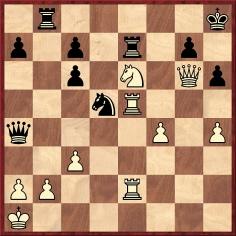
35 Qg4 Rd7 36 Nc5 Nxc3 37 Nxa4 Resigns.
Since 35 Qg4 allows 35...Qd1 mate, our correspondent wonders whether 35 Qg1 was played by White.
We believe that the explanation lies elsewhere. Although the game also appeared as above on page 23 of a 1997 booklet (published in Olomouc) on Berlin, 1881, page 166 of the tournament book by E. Schallopp (published in Leipzig in 1883) presented the conclusion as follows:
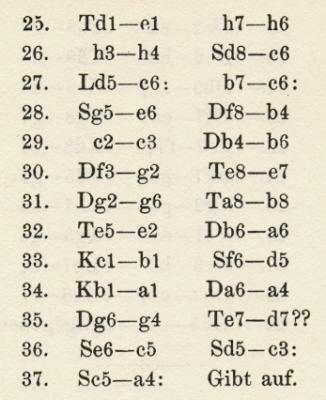
White’s 32nd move was given as R5e2, and not R1e2.
The full game-score in Schallopp’s tournament book is:
1 e4 e5 2 d4 exd4 3 Qxd4 Nc6 4 Qe3 d6 5 Bd2 Be7 6 Bc3 Bf6 7 f4 Qe7 8 Bb5 Bd7 9 Nf3 Nh6 10 Bxf6 Qxf6 11 Nc3 O-O 12 O-O-O Rfe8 13 h3 Qe7 14 g4 f5 15 Bc4+ Be6 16 Nd5 Bxd5 17 Bxd5+ Kh8 18 gxf5 Nxf5 19 Qc3 Ng3 20 Rhe1 Nd8 21 Ng5 Nh5 22 Qf3 Nf6 23 e5 dxe5 24 Rxe5 Qf8 25 Rde1 h6 26 h4 Nc6 27 Bxc6 bxc6 28 Ne6 Qb4 29 c3 Qb6 30 Qg2 Re7 31 Qg6 Rb8
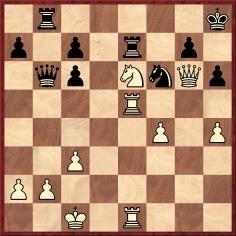
32 R5e2 Qa6 33 Kb1 Nd5 34 Ka1 Qa4 35 Qg4 Rd7 36 Nc5 Nxc3 37 Nxa4 Resigns.
6266. Marshall and Mannheim
Tony Gillam (Nottingham, England) has just had occasion to read pages 226-230 of Frank Marshall, United States Chess Champion by A. Soltis (Jefferson, 1994), regarding Mannheim, 1914. He comments:
‘Page 226: “the Austrian Archduke Francis Ferdinand was assassinated in late June 1914 ...” Franz Ferdinand (not “Francis”).
Page 229: “On Friday, 31 July, Marshall played what proved to be his last game in Europe for more than a decade. Fittingly, it was a victory against Janowsky, a 62-move Slav Defence.” On Friday, 31 July Marshall lost to Spielmann, a game and date which Soltis gave on the previous page. Marshall beat Janowsky in Round 11 (the last played) on Saturday, 1 August.
Page 230: “Ossip Bernstein did not play competitively for 18 years after St Petersburg [1914].” He played in a tournament at Le Pont in 1930.
Page 230: “Géza Maróczy had withdrawn even before the war, playing no public games between 1909 and a simultaneous exhibition in 1917.” Were San Sebastián, 1911 and his two tournaments in Budapest in 1912 played in private?”
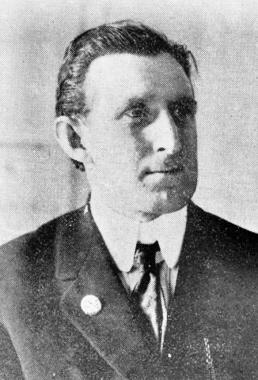
Frank James Marshall
We also note that on page 229 Soltis related Marshall’s reaction to the sound of gunfire in Mannheim ‘according to La Stratégie’. In reality, the French magazine (page 399 of the November 1914 issue) was expressing scepticism about the veracity of the claims in question, which had been published in Dutch outlets (De Telegraaf of 17 August 1914 and the August and September 1914 issues of Tijdschrift van den Nederlandschen Schaakbond).
The plates section of Frank Marshall, United States Chess Champion has a group photograph of Mannheim, 1914. It is dated 1924.
In C.N. 4738 John Hilbert catalogued many mistakes on pages 1-13 of Soltis’ book, which – appalling to relate – won the 1994 ‘Book of the Year’ award of the British Chess Federation. Page 666 of the December 1994 BCM named the judges as Ray Edwards and John Littlewood.
6267. Pillsbury’s passport application
Olimpiu G. Urcan (Singapore) has sent us H.N. Pillsbury’s passport application, dated 1895, from the Passport Application 1795-1905 database provided by www.footnote.com.
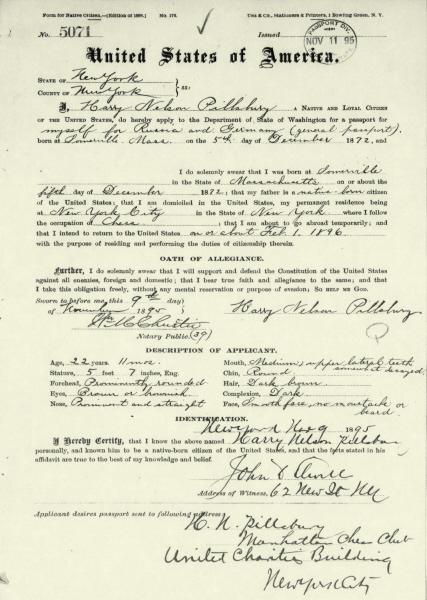
6268. Capablanca’s defeats
‘The Cuban world champion José Capablanca admitted that he learned only from his losses.’
Source: Evans on Chess by Larry Evans (New York, 1974), page 17.
‘... from few won games have I learned as much as I have from most of my defeats.’
Source: Author’s note in My Chess Career by J.R. Capablanca (London, 1920) and quoted on page 40 of Evans on Chess.
6269. Consultation game
Frank James Marshall, Léonardus Nardus and B. Hallegua – M.D. Altintope, de Cramer and A. TéléguineParis, 10 April 1914
Sicilian Defence
1 e4 c5 2 b4 cxb4 3 a3 d5 4 e5 Nc6 5 d4 e6 6 axb4 Bxb4+ 7 c3 Ba5 8 Qg4 Nge7 9 Bd3 Ng6 10 Nf3 Qc7 11 O-O Bd7 12 Ba3 Nce7 13 Bd6 Qd8 14 Bxe7 Kxe7 15 h4 h5 16 Qg5+ Kf8 17 Bxg6 fxg6 18 Qxg6 Rh6 19 Qg3 Bb6 20 Ng5 Qe7 21 f4 g6 22 Nd2 Kg7
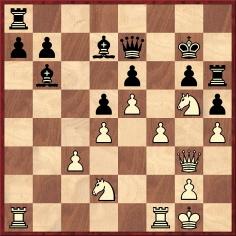
23 f5 exf5 24 Rfb1 Rf8 25 e6 Bc6 26 Rxb6 axb6 27 Qe5+ Rf6 28 c4 dxc4 29 d5 Qc5+ 30 Kh2 Qxd5 31 Qc7+ Kf8 32 Ra8+ Be8 33 e7+ Kg7 34 Rxe8 Rc6
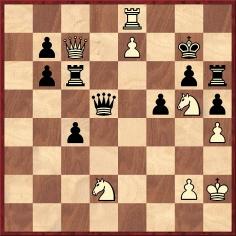
35 Rg8+ Qxg8 36 Qe5+ Resigns.
Source: La Stratégie, April 1914, pages 164-165 (with brief notes by Marshall).
6270. Oscar Chajes
C.N. 1546 (see page 158 of Chess Explorations) stated that Oscar Chajes was born in Russia, but Henk Smout (Leiden, the Netherlands) now points out that Chajes’ birthplace, Brody, ‘was in the Austrian kingdom of Galicia and Lodomeria, on the border with Russia, but still in Austria, and now in Western Ukraine’.
We note that the master’s obituary in the New York Times, 29 February 1928, page 19, stated: ‘A native of Galicia, Chajes had lived here since 1904’, his address in New York at the time of his death being 15 East Twenty-first Street.
6271. Capablanca photographs
The first photograph below, featuring Mordecai Morgan on the right, was published in Walter Penn Shipley by John S. Hilbert (Jefferson, 2003), and is reproduced here with Dr Hilbert’s permission. In the second photograph, which comes from our collection, Capablanca’s opponent may be Isaac L. Rice. We estimate that the pictures were taken in 1915, but information on the occasion is unavailable. The board positions appear similar, if not identical.
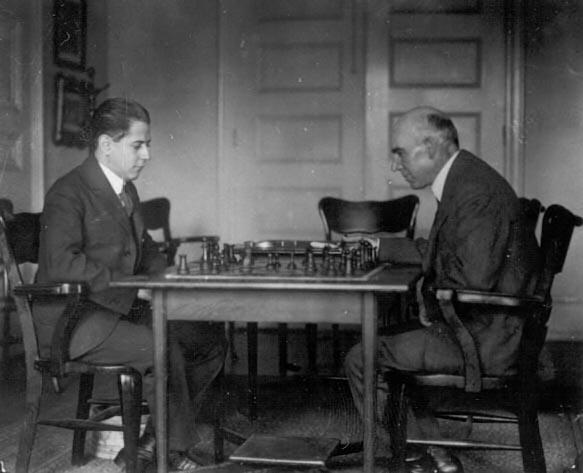
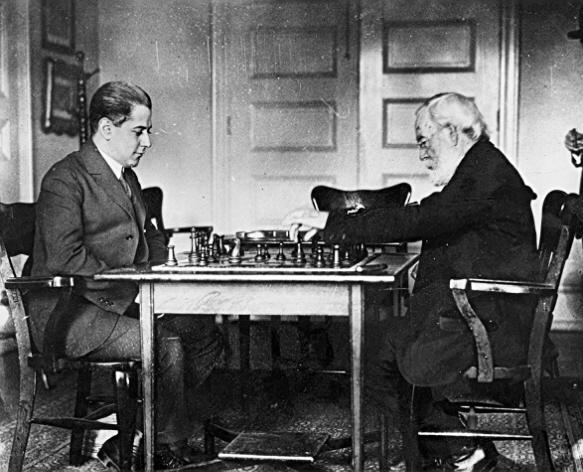
6272. Friedrich Sämisch
Thomas Olsson (Lund, Sweden) notes that surprisingly little biographical information is available about Friedrich Sämisch.
He certainly deserves more detailed treatment than that provided in the 63-page booklet Schach- und Lebenskünstler Friedrich Sämisch by Helmut Wieteck (Nuremberg, 1987).
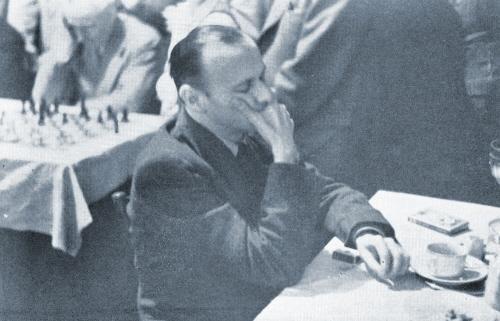
Friedrich (Fritz) Sämisch
6273. Four exchange sacrifices
A game received from Lawrence Stevens (Temple City, CA, USA):
Timothy Thompson – Lawrence StevensPellant Memorial, Pasadena, 14 August 2009
Sicilian Defence
1 e4 c5 2 Nf3 d6 3 d4 cxd4 4 Nxd4 Nf6 5 Nc3 g6 6 Be3 Bg7 7 f3 Nc6 8 Qd2 O-O 9 Bc4 Bd7 10 O-O-O Qa5 11 Kb1 Rfc8 12 Bb3 Ne5 13 g4
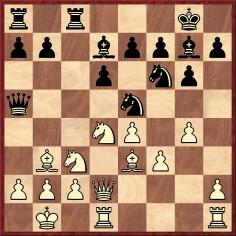
13...Rxc3 14 Qxc3 Qxc3 15 bxc3 Rc8 16 g5 Ne8 17 f4 Nc4 18 Bc1 b5 19 Rhe1 Nb6 20 e5 dxe5 21 fxe5 e6 22 Bf4 Nc7 23 Ne2 Ncd5 24 Bxd5 Nxd5 25 Kb2 Bc6 26 Rxd5 Bxd5 27 Nd4 Bf8 28 a3 a6 29 Rd1 Rc4 30 Bg3 Be7 31 h4 Bxa3+ 32 Kxa3 Rxc3+ 33 Kb4 Rxg3 34 Ra1 Bb7 35 Rd1 Rg4 36 Kc5 Bd5 37 Ra1 Rxh4 38 Rxa6 Rg4 39 Rb6 Rxg5 40 Rxb5 Rxe5 41 Kd6 Re4 42 Rxd5 exd5 43 Kxd5 Rxd4+ 44 Kxd4 h5 45 c4 h4 46 c5 Kf8 47 White resigns.
Our correspondent asks whether any games between masters have featured four sacrifices of the exchange.
6274. Nazi articles
‘The best argument in support of Alekhine’s later contention that the articles were forgeries is that, wholly apart from their being hateful, they are utterly inane, but Alekhine’s denial that he was the author was not enunciated until March 1946; by that time, the movement to ostracize him had already gained considerable support. An invitation to the tournament at London in January of 1946 was withdrawn at the insistence of the United States federation, and there were suggestions from several quarters that he be somehow stripped of his title.
Alekhine defended himself in an open letter to the editor of the Australian magazine Chess World, in which he stated that “of the articles which appeared in 1941 during my stay in Portugal ... nothing was actually written by me”.’
Source: page 119 of The World Chess Championship A History by Al Horowitz (New York, 1973).
The open letter was written not to the editor of Chess World (C.J.S. Purdy) but to W. Hatton Ward, the organizer of the London, 1946 tournament; Purdy merely reproduced the letter in the 1 March 1946 issue of his magazine (pages 26-27). See also pages 263-267 of The Personality of Chess (New York, 1963), a book which Horowitz co-authored with P.L. Rothenberg.
Alekhine’s letter was written from Madrid on 6 December 1945, but Horowitz’s error over the timing of a denial (‘not enunciated until March 1946’) is more significant than that. As mentioned in our article Was Alekhine a Nazi?, the first disavowal by Alekhine appears to date from just after the liberation of Paris. The December 1944 BCM (pages 274-275) and the January 1945 CHESS (page 53) reported Alekhine’s statement in a published interview (News Review, 23 November 1944 was the source given in CHESS) that while in France (to quote the BCM text) ‘he had to write two chess articles for the Pariser Zeitung before the Germans granted him his exit visa ... Articles which Alekhine claims were purely scientific were rewritten by the Germans, published and made to treat chess from a racial viewpoint.’
Below is part of the front cover of the January 1945 CHESS (published in December 1944):
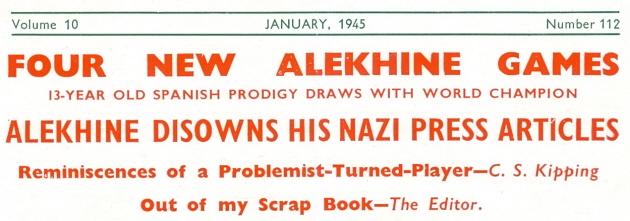
From page 53 of the same issue:
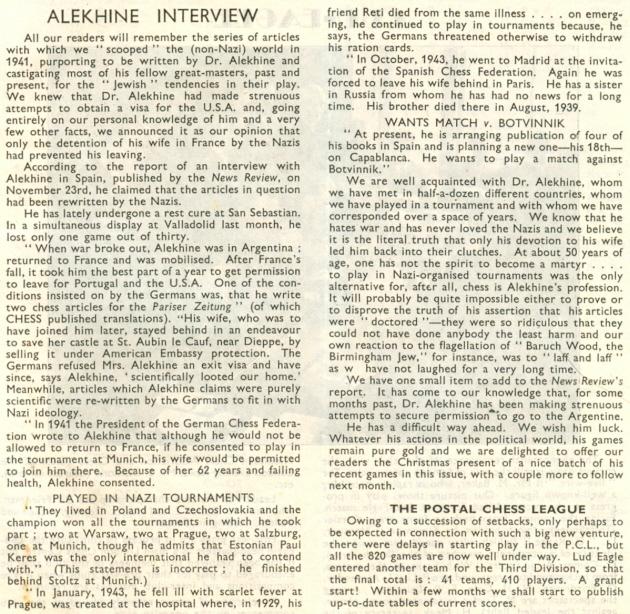
Does any reader have the full original interview in News Review?
Other writers have erroneously claimed that Alekhine did not deny authorship of the articles until after the War. See, for example, page 198 of Grandmasters of Chess by H. Schonberg (Philadelphia and New York, 1973) and page 174 of The World of Chess by A. Saidy and N. Lessing (New York, 1974). The fact that Alekhine made a public denial some five months before the Third Reich fell is, of course, open to discussion in terms of its political and practical significance, but it is still a fact, and one often ignored.
6275. Schonberg inscription
The half title of one of our copies of H. Schonberg’s Grandmasters
of
Chess (1973 edition):
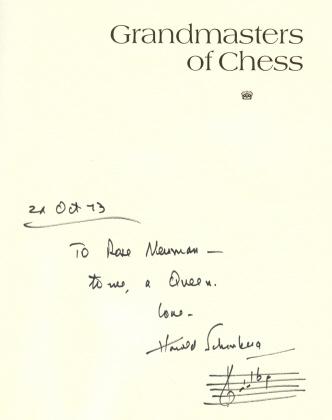
6276. Missed mate in one
There cannot be many books by a master in which a move awarded an exclamation mark allows mate in one. From page 95 of The Fireside Book of Chess by I. Chernev and F. Reinfeld (New York, 1949):
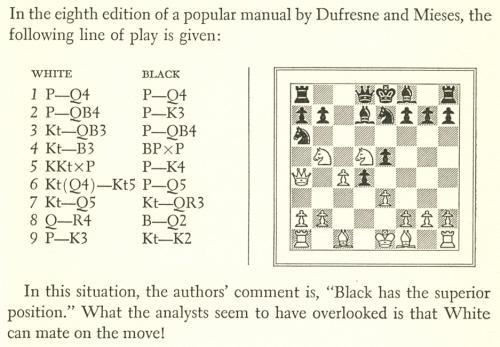
Concerning the references to ‘the authors’ comment’ and ‘the analysts’, it should be noted that the eighth edition of the book in question, Kleines Lehrbuch des Schachspiels, was published in 1910, i.e. some 17 years after Dufresne’s death. The title page:
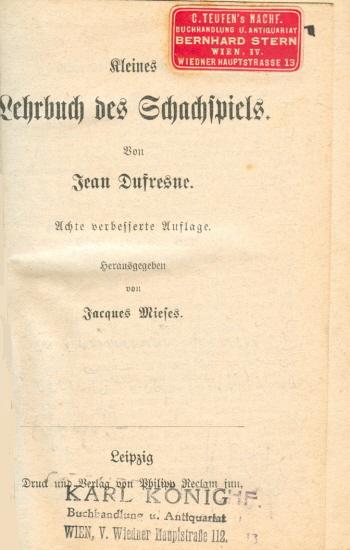
Below is the relevant section of page 398, in a note to 8 e3:
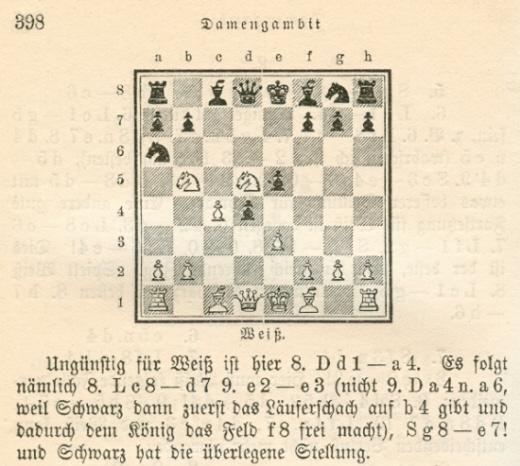
We should like to establish when the blunder first appeared in the book and when it was corrected. The following appeared on page 397 of the tenth edition, published in 1923:

6277. Quiz question
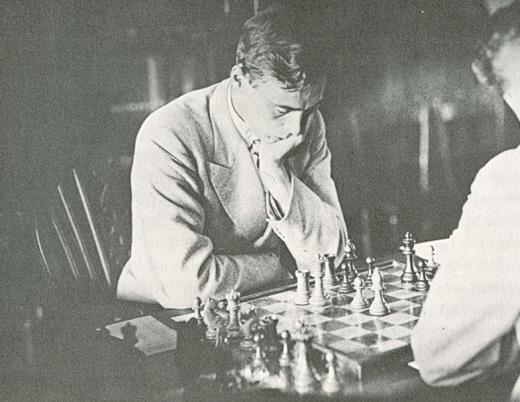
Identifying this master is not difficult, but who was his opponent and what was the occasion?
6278. 1 e4 e5 2 h4
From page 7 of the Glasgow Weekly Herald, 24 April 1875:
A.K. Murray – Johannes Hermann ZukertortLondon, 1875
King’s Pawn Opening
(Notes by Zukertort)
1 e4 e5 2 h4 (‘Unusual, and certainly not advisable.’) 2...Nc6 3 Nc3 Bc5 4 d3 f5 (‘The wisdom of this move may be doubted.’) 5 Be3 Be7 6 g3 Nf6 7 exf5 (‘This pawn should have been taken at once, or not at all.’) 7...d5 8 Bg5 Bxf5 9 Bxf6 Bxf6 10 Bg2 Be6 11 Qe2 (‘11 Qd2 was preferable.’) 11...Nd4 12 Qd2 c6 13 Nce2 O-O 14 Nxd4 exd4 15 O-O-O c5 16 Kb1 c4 17 dxc4 dxc4 18 Qb4 (‘This move prevents the immediate sortie of the adverse queen, but Black’s superiority in position is decisive against any play.’) 18...a5 19 Qb5 Ra6 20 Qxb7 (‘Certainly not improving his game by this move.’) 20...Rb6 21 Qe4
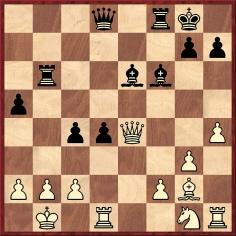
21...Rxb2+ (‘The soundest line of play here was 21...d3 22 b3 a4.’) 22 Kxb2 Qb6+ 23 Kc1 c3 24 Qb7 Qd6 25 Re1 Rb8 26 Qxb8+ (‘The more favourable line for White was 26 Rxe6 Qa3+.’) 26...Qxb8 27 Be4 Bc4 28 Ne2 Qb2+ 29 Kd1 d3 30 White resigns.
The Herald gave no details regarding the occasion. Under the heading ‘Chess in London’ it merely reported that the game ‘was played recently’ and that Murray belonged to the Glasgow Chess Club.
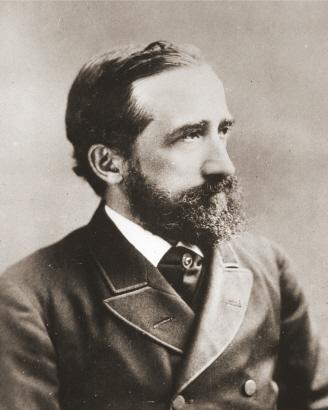
Johannes Hermann Zukertort
6279. Tarrasch v the Allies (C.N. 5161)
C.N. 5161 named the four Italian players against whom Tarrasch won a game in Naples in 1914 which featured the spectacular move 31 Bc7.
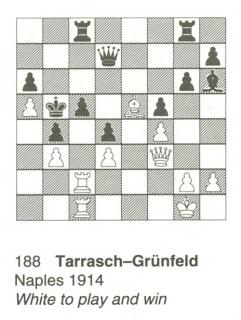
As shown above, on page 117 of the Chess Traveller’s Quiz Book (London, 1993) Julian Hodgson inexplicably identified Black as Grünfeld, also adding black pawns on f5 and g6.
6280. Missed mate in one (C.N. 6276)
Frederick S. Rhine (Park Ridge, IL, USA) draws attention to page 96 of On Top of the Chess World by L. Christiansen, J. Fedorowicz and I. Gurevich (San Francisco, 1995), where Gurevich annotated the 14th match-game between Kasparov and Anand:
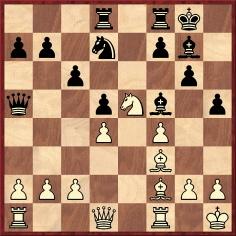
Anand’s 17...Qc7 received this comment by Gurevich:
‘Black could not do without this move, since 17...f6 18 Nd3 Nb6? is bad due to 19 Be1! Qb5 19 [sic] Nc5.’
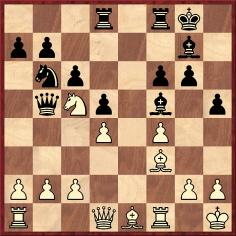
Mr Rhine comments: ‘20...Qxf1 mate would be a strong rejoinder.’
6281. Missed mate in one (C.N.s 6276 & 6280)
Another instance is pointed out by our correspondent Frederick S. Rhine, from page 197 of Complete Defense to King Pawn Openings by Eric Schiller (New York, 1998). The game is Ghinda v W. Watson, Thessaloniki, 1988:
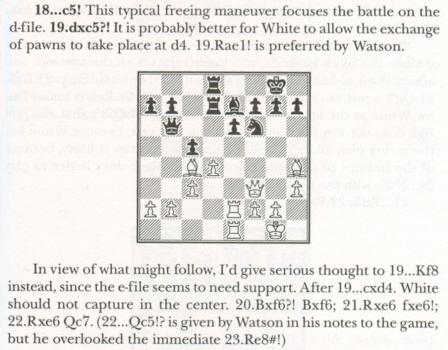
The position after 22 Rxe6:
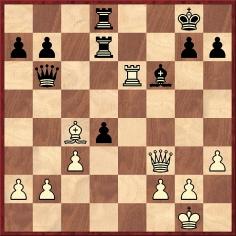
Schiller observes that Watson’s suggestion 22...Qc5 allows 23 Re8 mate. So, instead, Schiller recommends 22...Qc7, overlooking that it allows 23 Re8 mate.
6282. Manchester, 1890
Kevin Marchese (Canal Winchester, OH, USA) is collecting games from the Manchester, 1890 tournament (won by Tarrasch three points ahead of Blackburne) and currently has 91 of the 190 played. Of Tarrasch’s games, only his draw with Lee is absent, but just four of Bird’s games (against Blackburne, Gunsberg, Schallopp and Tarrasch) have been found so far. Can readers help fill in any gaps?
6283. Correspondence games by world champions (C.N. 3719)
Javier Asturiano Molina (Murcia, Spain) notes that pages 29-30 of The Unknown Bobby Fischer by John Donaldson and Eric Tangborn (Seattle, 1999) gave a 12-move loss by Fischer in 1955 against A.W. Conger. The game being well known today, we refrain from going into the details here.
6284. Another Tarrasch quote
‘Tarrasch once observed that if one piece stands badly, all the pieces stand badly.’
Source: Planning by Neil McDonald (London, 1995), page 19.
As in the case of the ‘Tarrasch and the gods’ quote (C.N. 6218), more than one source can be provided for such a remark:
- ‘Wenn eine einzige Figur schlecht steht, steht eben oft das ganze Spiel schlecht.’ Page 18 of Tarrasch’s book on Ostend, 1907.
- ‘Wenn eine Figur schlecht steht, steht meist das ganze Spiel schlecht.’ Page 333 of Tarrasch’s Die moderne Schachpartie (Leipzig, 1916).
Those wordings (with ‘often’ and ‘usually’) are not as categorical as the McDonald version, but there may well be further occurrences of a similar observation elsewhere in Tarrasch’s writings.
6285. Quiz question (C.N. 6277)

This photograph was published on page 12 of The Encyclopedia of Chess by H. Golombek (London, 1977) with the caption ‘C.H.O’D. Alexander in play against Sultan Khan, Hastings, 1933/4’. By the time of that tournament Sultan Khan had left Europe, and the event in question was the British Championship in Hastings, July-August 1933. The game was given on pages 129-130 of Mir Sultan Khan by R.N. Coles (St Leonards on Sea, 1977):
Sultan Khan – Conel Hugh O’Donel AlexanderHastings, 1 August 1933
Grünfeld Defence
1 c4 Nf6 2 Nc3 g6 3 d4 d5 4 Bg5 Be6 5 Qb3 dxc4 6 Qxb7 Nbd7 7 Nb5 Nd5 8 e4 Rb8 9 Qc6 Rb6 10 Qxc4 a6 11 exd5 axb5 12 Qb3 Bf5 13 Bxb5 Bg7 14 Ne2 O-O 15 a4 Nf6 16 Nc3 Ne4 17 Be3 Nd6 18 Qa2 Nxb5 19 axb5 Bd3 20 Qb3 Qd7 21 Ra5 Rfb8 22 Qa4 Bxb5 23 Nxb5 Rxb5 24 Rxb5 Qxb5 25 Qxb5 Rxb5 26 Kd2 Rxd5 27 Kd3 Rb5 28 Rc1 Rxb2 29 Rxc7 Bf8 30 d5 Rb8 31 Bc5 Re8 32 Kc4 Kg7 33 g4 g5 34 Kb5 Kf6 35 Bd4+ Kg6 36 Kc6
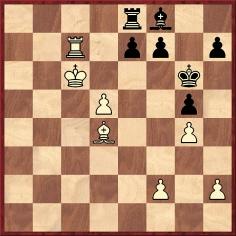
36...Rd8 37 Bc5 Kf6 38 h3 h6 39 Bb4 Rb8 40 Rb7 Rxb7 41 Kxb7 Ke5 42 Kc6 f5 43 Bc3+ Ke4 44 gxf5 Kxf5 45 Kd7 Ke4 46 Ke8 Kxd5 47 Kxf8 Resigns.
6286. Daniel Harrwitz
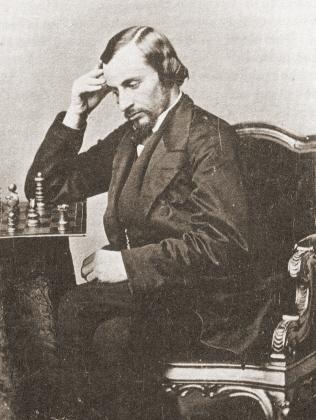
Daniel Harrwitz
From Luca D’Ambrosio (Bolzano, Italy):
‘Standard reference works, such as Gaige’s Chess Personalia (page 163) and Chicco and Porreca’s Dizionario enciclopedico degli scacchi (page 266), give 9 January 1884 and Bolzano/Bozen as the date and place of Daniel Harrwitz’s death.
In July 2009 I checked the Totenbuch Number 12, 1884-1895 (Dompfarre M. Himmelfahrt, Bozen), page 1. It reported that Harrwitz died at 5 a.m. on 2 January 1884, at the age of 63, the cause of death being “lung paralysis” (“Lungenlähmung”). Under “Religion” it was stated “Israelit”, and his last address was “Zollstange 173” in Bolzano.
Following on from this information, I managed to find Harrwitz’s grave in the Jewish Cemetery in Bolzano. My photographs were taken on 17 July 2009, with the kind permission of the Jewish Community of Meran/Merano.
The gravestone has the following inscription:
“Hier ruhet
unser guter Bruder u. Onkel
Professor
D. Harrwitz
geb. in Breslau d. 22.2.1821
gest. in Bozen d. 2.1.1884.”
The death-date on the gravestone is the same as that given in the Totenbuch. Any remaining doubts about its correctness are removed by verification of what was published on page 4 of the Bozner Zeitung of 4 January 1884:
“Verstorbene im Bezirke Bozen.
(...)
2. Jänner. Dr. Harwitz [sic], led. Professor aus Breslau, 63 J. alt, an Lungenlähmung.”
It is therefore certain that his widely-reported date of death, 9 January 1884, is wrong.
Now I turn to his date of birth. The Totenbuch and the gravestone are significantly at variance with the information commonly given in such works as those by Gaige and Chicco/Porreca referred to above, i.e. 29 April 1823, in Breslau. The day, month and year are all different from what appears on the gravestone (22 February 1821). If the gravestone and the Totenbuch are correct, Harrwitz was born over two years earlier than was previously believed, and he died at the age of nearly 63.
The inscription on the gravestone indicates that Harrwitz was survived by relatives (“unser guter Bruder und Onkel”), which to me is a strong argument in favour of the correctness of the gravestone date.
It would be interesting to know whether any documentation in Breslau/Wrocław (Poland) confirms the birth-date on the gravestone.
For assistance with my research I should like to thank Pater Plazidus (Benediktinerkloster Muri-Gries, Bolzano/Bozen), Mrs Streiter (Dompfarre Maria Himmelfahrt, Bolzano/Bozen) and the Jewish Community of Merano/Meran.’
6287. N.N. v N.N.
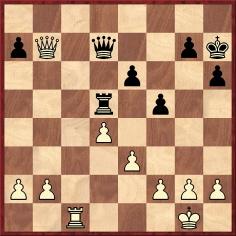
White played the powerful-looking 1 Rc7, but the move lost outright to 1...Rc5.
The position has been widely published, with no identification of the players and no particulars other than ‘Yugoslavia, 1949’. One example among many is page 90 of How to Play The Middle Game in Chess by John E. Littlewood (London and Glasgow, 1974). Can anything more be discovered about the position? When, for instance, did it first appear in print?
6288. Missed mate in one (C.N. 6276)
From Andreas Saremba (Brieselang, Germany):
‘Mieses’ error was introduced in the eighth edition. The seventh edition (1901) had only six pages of variations on the Queen’s Gambit (as opposed to 13 pages in the eighth edition) and did not even mention the Tarrasch Defence (3...c5).
The error was corrected on page 397 of the ninth edition, published in 1916, through the interposition of ...Bb4+ before ...Ne7.’

6289. Blindfold chess by women
Eliot Hearst (Tucson, AZ, USA) writes:
‘What is the record for the number of simultaneous blindfold games played by a woman? In all the research for our book Blindfold Chess John Knott and I never came across any report of a scheduled, well-regulated blindfold simultaneous display by a woman.’
6290. Who? (C.N. 6260)

An article by Walter Penn Shipley on pages 93-94 of the June 1907 issue of Lasker’s Chess Magazine was entitled ‘Capt. Julius A. Kaiser – Champion Problem Solver of the World’.
Shipley wrote:
‘For years he has ranked in the first class of the world’s solvers, and in my judgment has no superior and but few, if any, equals, not only for the accuracy of his work but also in the matter of rapidity.’
After Kaiser’s death in 1915, B.G. Laws professed ‘some astonishment that the western continent proclaim him as being at the time of his decease the champion solver of the world’ (BCM, March 1915, pages 105-106). Reacting to Laws’ comments, the May-June 1915 American Chess Bulletin (page 127) made do with describing Kaiser as ‘a splendid solver, with few peers’.
He was also an accomplished composer. Below is a three-mover from page 127 of the Brooklyn Chess Chronicle, 15 May 1886:
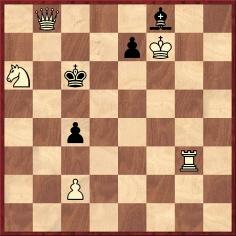
6291. Reinfeld v Alekhine
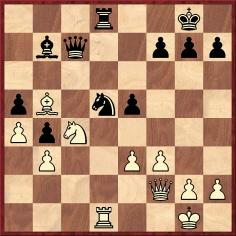
This position arose after 27 Rf1-d1 in Reinfeld v Alekhine, Pasadena, 1932.
John Blackstone (Las Vegas, NV, USA) notes a discrepancy over Black’s 27th move and the remainder of the game:
A) 27...Nc3 28 Rxd8+ Qxd8 29 Qd2 Qxd2 30 Nxd2 Bd5 31 e4 Be6 32 Bc4 Bc8 33 Bb5 Be6 34 Bc4 Bc8 35 Kf2 Kf8 36 Bb5 Be6 37 Bc4 Bc8 38 Bb5 Drawn. (Los Angeles Times, 26 August 1932, page A8.)
B) 27...Nb6 28 Rxd8+ Qxd8 29 Qd2 Qxd2 30 Nxd2 Bd5 31 e4 Be6 32 Bc4 Bc8 33 Kf2 Kf8 34 Bb5 Be6 35 Bc4 Bc8 36 Bb5 Drawn. (Various databases.)
We add that Version A was given on page 431 of the Skinner/Verhoeven volume on Alekhine, which also mentioned as a source pages 8-9 of the 11/1932 issue of The Chess Reporter. This version was published too on page 1885 of L’Echiquier, 28 November 1932.
Has Version B, which entails various errors in the final phase, ever appeared in an authoritative publication?
A hybrid version (27...Nb6 28 Rxd8+ Qxd8 29 Qd2 Qxd2 30 Nxd2 Bd5 31 e4 Be6 32 Bc4 Bc8 33 Bb5 Be6 34 Bc4 Bc8 35 Kf2 Kf8 36 Bb5 Be6 37 Bc4 Bc8 38 Bb5 Drawn) is on page 92 of The Games of Alexander Alekhine by R. Caparrós and Peter P. Lahde (Brentwood, 1992).
6292. More incorrigibility
As is well known, Yasser Seirawan was born in Damascus, of a Syrian father and a British mother. However, on page 53 of his book Docklands Encounter (London, 1984) Raymond Keene claimed that Seirawan was ...
‘... born in England of mixed US and Syrian parentage’.
Page 278 of Warriors of the Mind (Brighton, 1989), a book co-bungled with Nathan Divinsky, re-affirmed that Seirawan was ...
‘... born in England of mixed US and Syrian parentage’.
When Warriors of the Mind was re-issued in 2002, the errors were, of course, left untouched.
Four years later, Messrs Keene and Divinsky, together with Jeff Sonas, produced a book entitled Who was the Strongest? Warriors of the Mind II. Page 270 stated that Seirawan was ...
‘... born in England of mixed US and Syrian parents’.
| First column | << previous | Archives [61] | next >> | Current column |
Copyright: Edward Winter. All rights reserved.


